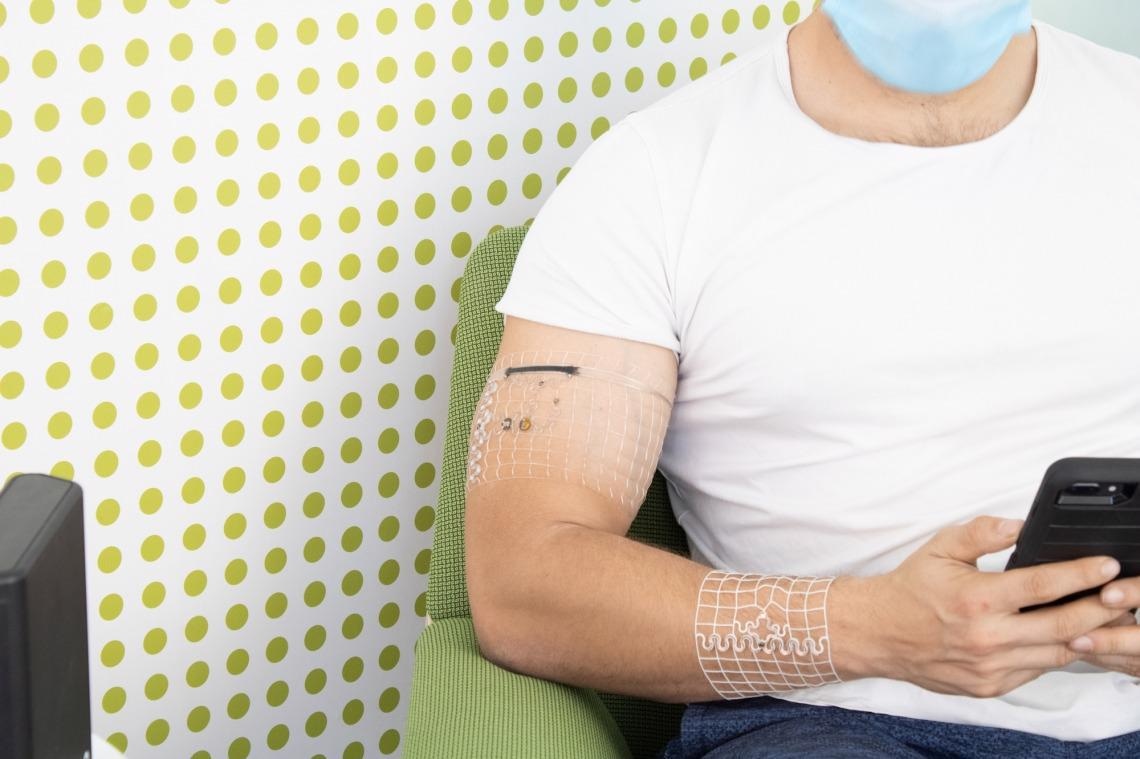Wearable sensors to track a range of things from step count to heart rate are nearly everywhere. But for situations such as quickly diagnosing fatal diseases, testing the effectiveness of new drugs, computing the beginning of frailty in older adults or monitoring a professional athlete’s performance, medical-grade devices are necessary.
 University of Arizona engineers have developed a way to 3D-print medical-grade wearable devices, such as this one, based on body scans of the wearer. Image Credit: Philipp Gutruf/College of Engineering, University of Arizona.
University of Arizona engineers have developed a way to 3D-print medical-grade wearable devices, such as this one, based on body scans of the wearer. Image Credit: Philipp Gutruf/College of Engineering, University of Arizona.
Engineers from the University of Arizona have created a type of wearable they refer to as a "biosymbiotic device," which has a number of extraordinary benefits. The devices are not only custom 3D-printed and placed on body scans of wearers but they can also work uninterruptedly using a wireless power transfer and compact energy storage combination.
The team, headed by Philipp Gutruf, assistant professor of biomedical engineering and Craig M. Berge Faculty Fellow in the College of Engineering, reported its findings recently in the journal Science Advances.
There's nothing like this out there. We introduce a completely new concept of tailoring a device directly to a person and using wireless power casting to allow the device to operate 24/7 without ever needing to recharge.
Philipp Gutruf, Assistant Professor of Biomedical Engineering and Craig M. Berge Faculty Fellow, College of Engineering, University of Arizona
Gutruf is also a member of the BIO5 Institute at the University of Arizona.
Custom Fit Enables Precise Monitoring
Existing wearable sensors are challenged by several limitations. Smartwatches, for example, have to be charged, and they can only collect limited amounts of data because of their placement on the wearer’s wrist.
By employing 3D scans of a wearer's body, which can be collected through techniques including CT scans, MRIs and even meticulously combined smartphone images, Gutruf and his team can 3D-print custom-fitted devices that can be placed around different body parts.
The device will be virtually concealed, breathable, lightweight, mesh cuff engineered especially for one’s calf, bicep or torso. The ability to specialize the placement of the sensor enables the scientists to quantify physiological factors they otherwise could not.
If you want something close to core body temperature continuously, for example, you'd want to place the sensor in the armpit. Or, if you want to measure the way your bicep deforms during exercise, we can place a sensor in the devices that can accomplish that. Because of the way we fabricate the device and attach it to the body, we're able to use it to gather data a traditional, wrist-mounted wearable device wouldn't be able to collect.
Tucker Stuart, Study First Author and Doctoral Student in Biomedical Engineering, University of Arizona
Since these biosymbiotic devices are tailor-made to fit the wearer, they are also very sensitive. Gutruf's team tested the ability of the device to track parameters such as temperature and strain when a person walked on a treadmill, jumped and used a rowing machine.
In the rowing machine test, subjects wore a number of devices, monitoring exercise intensity and the way muscles deformed with precise detail. The devices were sufficiently accurate to detect variations in body temperature triggered by walking up a single flight of stairs.
Continuous, Wireless and Effortless
Gutruf and his team are not the first to test out wearables to monitor health and body function. Yet, existing wearables do not possess the ability to monitor metrics nonstop, or with adequate precision to make medically significant conclusions.
Some wearables used by scientists are patches that adhere to the skin, but they fall off when the skin undergoes its usual shedding process, or occasionally when a subject sweats. Even very advanced wearables employed in clinical settings, such as ECG monitors, have to deal with these challenges.
Also, they are not wireless, which significantly restricts mobility. Patients cannot move about and do their normal regular routines if they are fastened to bulky external devices.
Gutruf's team's biosymbiotic device does not use any adhesive, and it receives its energy from a wireless system with a range of different meters. The device also consists of a small energy storage unit, so it will work even if the wearer moves beyond the system's range, for instance, out of the house.
These devices are designed to require no interaction with the wearer. It's as simple as putting the device on. Then you forget about it, and it does its job.
Philipp Gutruf, Assistant Professor of Biomedical Engineering and Craig M. Berge Faculty Fellow, College of Engineering, University of Arizona
This study received funding from the Flinn Foundation Translational Bioscience Seed Grants Pilot Program. The team has also been partnering with Tech Launch Arizona, the commercialization division of the university, to safeguard the intellectual property and set up a startup to present the technology to the market.
3D-Printed Customized Wearables to Monitor Health Without the Need to Recharge
Video Credit: University of Arizona
Journal Reference:
Stuart, T., et al. (2021) Biosymbiotic, Personalized and Digitally Manufactured Wireless Devices for Indefinite Collection of High-Fidelity Biosignals. Science Advances. doi.org/10.1126/sciadv.abj3269.